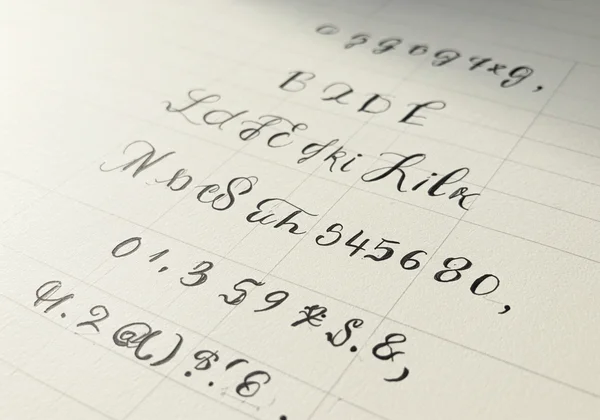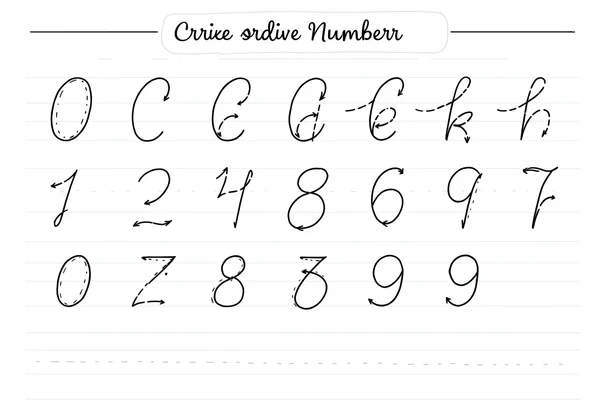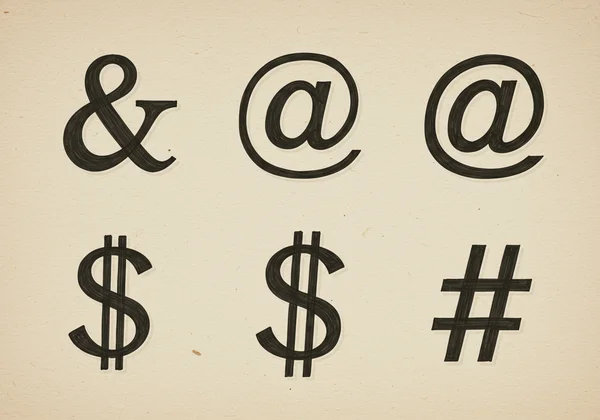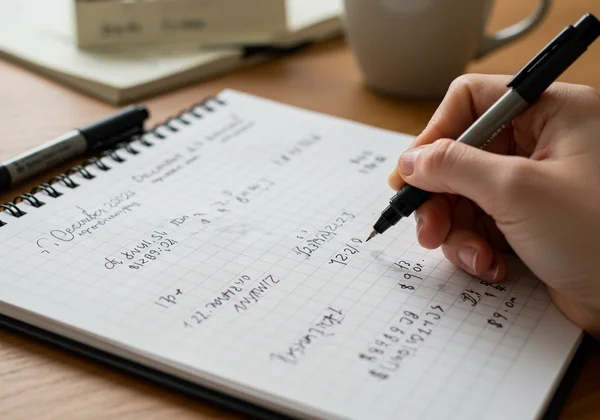Beyond the Cursive Alphabet: Mastering Numbers and Essential Symbols
You've practiced the looping 'l', the elegant 'S', and the entire cursive alphabet. But what happens when you need to write a date, an email address, or a price? Many learners master letters only to find themselves stuck on the basics of cursive numbers and symbols. This guide fills that gap, providing clear, step-by-step instructions to help you write numerals and essential symbols with the same grace and flow as your letters.
True cursive mastery extends beyond the A-Z. By learning to form numbers and symbols correctly, you unlock complete fluency in your handwriting. Whether you're a student aiming for neater assignments, a teacher looking for comprehensive resources, or a hobbyist perfecting your craft, this guide is your next step. Let’s expand your skills and explore the full potential of beautiful handwriting with our free learning resources.

Expanding Your Cursive Alphabet: Writing Numbers (0-9)
Unlike letters, cursive numbers do not typically connect to each other. However, they are designed with a similar fluid aesthetic to complement your script. The goal is to write them with a continuous, graceful motion that feels natural and looks consistent with your cursive letters alphabet. This section breaks down the formation of each numeral from 0 to 9.
Forming Each Cursive Number: Stroke Order and Flow
Achieving elegant cursive numerals starts with understanding the correct stroke order and motion. While there can be slight stylistic variations, the following represents a common and highly legible approach to number formation.
-
0 (Zero): Start at the top, just like a cursive 'O'. Make a smooth, counter-clockwise oval and close the loop at the top.
-
1 (One): Begin with a short upward flick from the baseline, then draw a straight diagonal line down to the right. A small horizontal line at the base can be added for stability.
-
2 (Two): Start with a small loop at the top, curve down and to the right, then finish with a straight horizontal line at the baseline.
-
3 (Three): This number is like two stacked curves. Start at the top, make a small curve to the right, loop back to the middle, and then create a larger curve to finish at the baseline.
-
4 (Four): Begin with a short downward stroke. Move horizontally to the right, then lift your pen and draw a longer vertical line that crosses the horizontal one.
-
5 (Five): Start with a short vertical line down. From the bottom of that line, create a large, open curve to the right, like the bottom of an 'S'. Finish by lifting your pen and drawing a straight horizontal line at the top.
-
6 (Six): This is one continuous motion. Start at the top, sweep down in a large curve, then loop inwards to create a closed circle at the bottom.
-
7 (Seven): Begin with a straight horizontal line at the top. From the right end of that line, draw a diagonal line down to the left. A small crossbar in the middle is optional but common.
-
8 (Eight): The most graceful way to form an '8' is to start at the top center, loop down to the left like an 'S', then cross upwards to the right to meet your starting point.
-
9 (Nine): Start by forming a small circle at the top, similar to a cursive 'a'. Once the circle is closed, extend the line straight down to the baseline.

Tips for Consistent Cursive Alphabet Numerals
Simply knowing the strokes isn't enough; consistency is key to making your numbers look professional and clean. Focus on these tips to refine your legible cursive numerals and ensure they blend seamlessly with your writing.
- Maintain a Consistent Slant: Your numbers should have the same forward slant as your cursive letters. This creates a visually cohesive look across the page.
- Uniform Size and Height: Ensure all your numbers are the same height, typically matching your capital letters or ascenders (like 'b' or 'h'). Numbers that are too big or small will disrupt the rhythm of your writing.
- Proper Spacing: Although numbers don't connect, the space between them should be consistent. Aim for a space roughly the width of a cursive 'o' to keep them from looking cramped or too spread out. You can find excellent examples on a cursive alphabet chart.
Mastering Essential Cursive Symbols
In our digital world, symbols are more important than ever. From email addresses to social media posts, knowing how to write cursive symbols adds a touch of personality and ensures your handwriting is versatile. Here’s how to tackle the most common ones.
The Art of the Cursive Ampersand (&) and At Sign (@)
The ampersand and at sign are two of the most frequently used symbols. Mastering their cursive forms will elevate your everyday writing.
- The Ampersand (&): The cursive ampersand is a beautiful symbol with historical roots. Start as if you're writing a cursive 'E'. As you loop back, instead of finishing the 'E', extend the line downwards and cross it with a final flourish. It combines elegance and function.
- The At Sign (@): This symbol is essentially a cursive 'a' with a long, sweeping tail that continues around it in a counter-clockwise motion. Start with the 'a', but don't stop; let the final stroke encircle the letter to form the '@'.
Cursive for Currency ($) and Hashtag (#) Symbols
Whether you're writing a check or jotting down notes, currency and hashtag symbols are indispensable. These are also considered fundamental cursive math symbols for practical use.
-
The Dollar Sign ($): The cursive dollar sign often begins like an 'S'. After forming a slightly elongated 'S', draw one or two straight vertical lines through its center. The key is to keep the 'S' shape fluid and the lines crisp.
-
The Hashtag (#): The hashtag, or number sign, is formed with two slightly slanted parallel vertical lines crossed by two slightly slanted parallel horizontal lines. Maintain the same slant as your other writing to ensure it looks like it belongs on the page. For designers, seeing this generated instantly can be a huge time-saver. Check out our free cursive generator to see how it looks.

Integrating Numbers & Symbols into Cursive Writing
Now that you know how to form individual numbers and symbols, the final step is to integrate them smoothly into your sentences and phrases. This is where practice moves from rote learning to practical application, making your cursive writing alphabet skills truly functional.
Practice Exercises for Real-World Contexts
The best way to build muscle memory is through repetition in meaningful contexts. Move beyond simple drills and try these handwriting practice exercises:
- Write out dates: "December 25, 2024" or "04/07/1998".
- Practice addresses: "123 Main St., Anytown, USA 54321".
- List prices: "$19.99", "$150.00", "$0.50".
- Jot down email addresses and social media handles: "[email protected]" or "@CursiveAlphabet #handwriting".
- Copy down phone numbers: "(555) 867-5309".
These exercises force you to switch between letters, numbers, and symbols, building the fluency needed for everyday writing. You can use our printable worksheets to get started. Explore our worksheets for endless practice.

Common Pitfalls and How to Overcome Them
Even with practice, learners can run into a few common issues. Here’s how to troubleshoot them:
- Inconsistent Slant: If your numbers stand straight up while your letters slant, your writing will look disjointed. Solution: Use lined paper with slant guides or practice writing numbers and letters together in the same word (e.g., "1st", "2nd").
- Poor Spacing: Crowding numbers or spacing them too far apart can ruin legibility. Solution: Consciously practice leaving a uniform gap between each numeral. This is a key step if you want to how to quickly learn cursive.
- Switching Back to Print: It’s a common habit to revert to printed numbers out of muscle memory. Solution: Be mindful during your practice sessions. Intentionally focus on forming the cursive version until it becomes second nature. Our online tool can help reinforce these new habits.
Your Journey to Full Cursive Fluency Continues
Fantastic work! You've gained the essential knowledge to write cursive numbers and essential symbols with confidence and style. You've moved beyond the basic alphabet in cursive and are on your way to complete handwriting fluency. Remember, the key to beautiful script is consistent, mindful practice.
Continue to use the resources available at Cursive Alphabet to refine your skills. Explore our individual letter guides, download unlimited worksheets, and experiment with the Cursive Font Generator to see your text transformed. Embrace the art of cursive in its entirety and watch your handwriting flourish.
Frequently Asked Questions About Cursive Numbers and Symbols
How do cursive numbers differ from standard printed numbers?
While many cursive numbers closely resemble their printed counterparts, they are designed with more fluid, continuous strokes to match the aesthetic of cursive script. For example, a cursive '2' or '7' may have small loops or flourishes that aren't present in the blocky print versions. The primary goal is to maintain flow and elegance.
Are there different styles for writing cursive numbers and symbols?
Yes, just like with the cursive alphabet, different handwriting systems (like D'Nealian or Zaner-Bloser) may have slight variations in how numbers and symbols are formed. However, the styles are generally similar and recognizable. Our platform teaches a widely accepted and legible style perfect for learners.
What is the best way to practice cursive numbers and symbols for fluency?
The best way is to integrate them into real-world writing. Instead of just drilling "1, 2, 3," practice writing phone numbers, dates, and recipes. This contextual practice builds muscle memory faster. Using the interactive tools on our site can make this practice engaging and effective.
Can Cursive Alphabet's Font Generator convert numbers and symbols?
Absolutely! Our Cursive Font Generator is a powerful tool that instantly converts any text—including numbers and common symbols like $, @, and &—into beautiful cursive script. It's a fantastic way for students to check their work or for designers to quickly create elegant text for a project. Try it today, generate the content strictly according to the following requirements